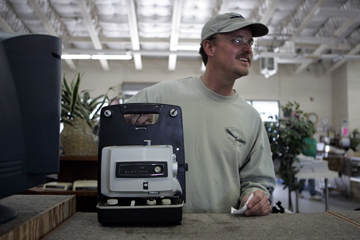
A resource recovery park in San Benito County could convert
waste products into usable material
At the Last Chance Mercantile people can buy clothing,
construction and remodeling materials, housewares, sporting goods
and even woodchips.
The for-sale items are all recovered from waste products.
Officials from the Monterey Regional Waste Management District
operate Monterey County’s resource recovery park.
A resource recovery park in San Benito County could convert waste products into usable material
At the Last Chance Mercantile people can buy clothing, construction and remodeling materials, housewares, sporting goods and even woodchips.
The for-sale items are all recovered from waste products.
Officials from the Monterey Regional Waste Management District operate Monterey County’s resource recovery park.
San Benito County could one day operate something similar, said Mandy Rose, San Benito County’s director of integrated waste management.
“Monterey County has a very successful Resource Recovery Park,” Rose said. “That took them 20-plus years to get to where they are today. We wanted to know if we could do it.”
Rose is writing a request for proposals (RFP) for a feasibility study of a resource recovery park in San Benito County.
A resource recovery park would grow over time, Rose said.
“The first goal is to get a construction and demo sorting line in,” Rose said. “After that, obviously do something with the green waste, wood waste.”
The feasibility study would answer questions such as, at what point could the county support a woodchipping operation or composting at a resource recovery park, Rose said.
“They’ll be able to give us some ideas of how much more material we need to make this work,” Rose said.
Other counties have ordinances in place that require contractors to recycle excess materials, Rose said.
“Most of them who work outside the county are used to it,” Rose said, “because in Santa Clara County, Monterey County, they’ve had to do that.”
Currently, county officials recycle construction materials, Rose said. The material must be presorted or it ends up in the county landfill, Rose said.
About half of construction material in the county, especially material from demolition projects, do not come in pre-sorted, Rose said. A resource recovery park would have the capacity to sort material, Rose said. Concrete, asphalt, wood, sheet rock, metal and roofing material are the most common construction materials received at the landfill, Rose said.
“If somebody has a mixed load of all that stuff, we don’t yet have the ability to separate all that,” Rose said.
Pre-sorted concrete is ground up and used for road base at the landfill, Rose said.
Wood is chipped or converted to energy, Rose said. Sheet rock is used for compost material, Rose said.
“People are demo-ing buildings and building new ones,” Rose said.
It is much harder to separate materials when a building is demolished, Rose said.
“It saves landfill space if we divert this material,” Rose said. “It also creates a future development opportunity for people taking those materials.”
The feasibility study would suggest kinds of business that San Benito County’s waste could support now and in the future, Rose said.
There are two possible sites for the resource recovery park, Rose said.
County officials own 133 acres of land adjacent to the landfill, Rose said. The study would look at that site and the site of the old landfill, Rose said.
The Board of Supervisors will review the RFP in late March or April. Once approved, the RFP will be open for 30 days, Rose said. Depending on the response, members of the board of supervisors would then approve a contract, Rose said.
A resource recovery park would keep county officials in compliance with state law, Rose said.
In 1989, California officials passed a law that necessitated 50 percent of a county’s garbage be diverted from landfills by the year 2000, Rose said.
“We are one of the counties that have not met that directive,” Rose said.
The county currently diverts about 47 percent of its garbage, according to a 2006 report, Rose said.
“There is a $10,000 a day fine, if you are not making a good faith effort,” Rose said.
Only county officials who have ignored the law have been fined, Rose said.
State officials are more involved in the affairs of counties that have not met 50 percent diversion, Rose said.
A resource recovery park for construction and demolition materials is a “strong suggestion” from the state, Rose said.









